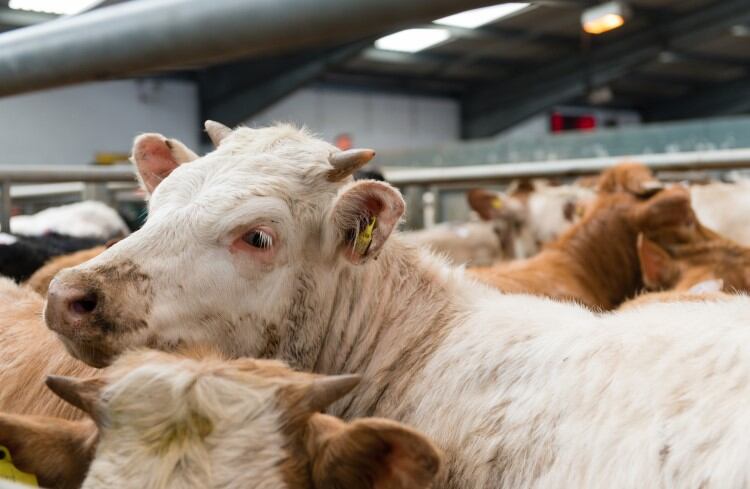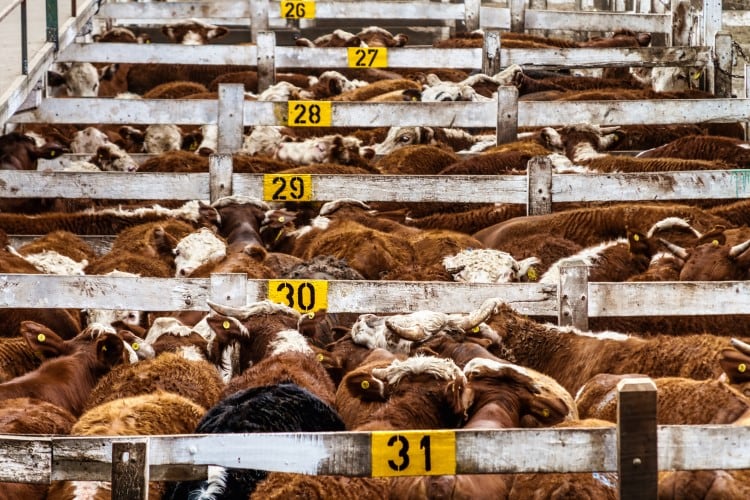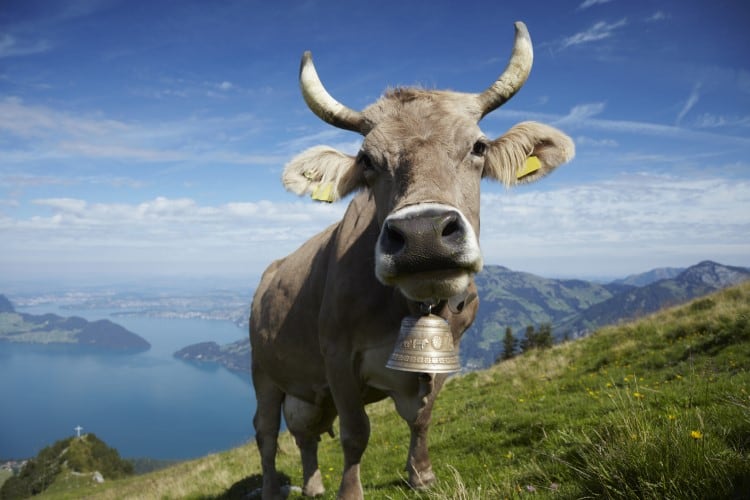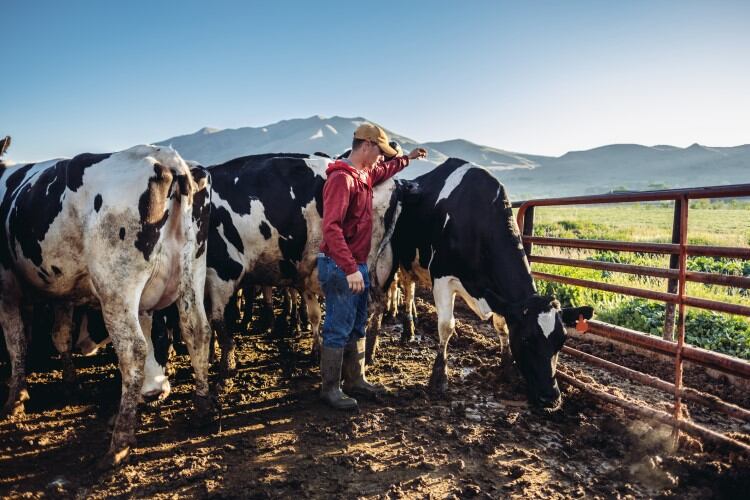In Canada and the US, around 26% and 28% of dairy cows respectively are slated for culling each year*. This is done if the cow is no longer productive or due to illness or injury. Animals are then either sold through an auction or transported directly to a slaughter plant.
But their journey is far from straightforward, according to World Animal Protection (WAP), the non-profit organization shedding light on a rarely-discussed problem – the welfare of cull dairy cows.
In its 27-page report, entitled Milking the cow: The fate of Canadian cull dairy cows, WAP outlines the shortcomings in the current slaughter system and makes recommendations over how it could be improved – and why the meat and dairy industry can benefit from better management and decision-making practices.
Research has shown that cull cows can experience welfare issues if the conditions of transport and handling are poor. According to the WAP report, dairy cows shipped from Canada to the US can be processed in plants as far as Texas, and even within Canada, the distance between farms and slaughterhouses can amount to more than 1,500 miles (2,500km). JBS, Cargill and the American Foods Group run some of the US slaughter plants that take Canadian dairy cows for culling.
To find out how animal welfare legislation for animals in transport is being enforced, the NPO gathered and analyzed inspection data from the Canadian Food Inspection Agency (CFIA). According to WAP, current regulations ‘have limited value in preventing producers from shipping compromised or unfit animals’ unless inspections are conducted, but because of the multi-jurisdictional nature of regulations and the gaps in oversight, animals that shouldn’t be transported ‘will fall through the tracks and will continue to deteriorate and suffer on the journey’.
‘A patchwork of federal and provincial statutes’
Canada relies on a multi-tier approach for conducting humane transport inspections. This involves provincial governments - each with its own animal protection legislation - and the CFIA at a federal level. For example, a dairy farmer sending cull cows to an auction should be inspected by provincial officials, while a consignment arriving at an auction or crossing the border would be inspected by the CFIA.
The federal agency told DairyReporter that it conducted around 25,000 humane transport inspection between April 1, 2021 and March 31, 2022, but ‘does not currently track the number of inspections that specifically include culls of dairy cows’. The frequency of these inspections was based on the ‘specific risk of each type of location’, we were told, but the spokesperson did not explain how the agency assesses risk.
CFIA uses the Health of Animals Regulations (HAR) to regulate how animals in transport should be treated. Inspectors mark consignments as ‘acceptable’ if those comply with the relevant HAR regs, or ‘unacceptable’ if non-compliance is suspected or proved, or if the inspector could not collect sufficient information, e.g. due to understaffing.
In the latter case, inspectors refer to the Standard Regulatory Response Process to determine enforcement actions. They must complete a non-compliance report documenting any welfare problems and suggest penalties, such as monetary fines, warning letters or prosecution.
Missing paperwork, excuses and a lack of transparency
But data obtained by WAP showed that around a quarter of the vehicles inspected by the CFIA contained cows with ‘animal welfare concerns’, including consignments that had been marked ‘acceptable’. In addition, some non-compliance reports were incomplete or missing, leaving question marks over the fate of the consignment or the parties responsible for its transport.
Across the 76 cases that contained welfare problems, only one fine had been issued, WAP found. In addition, veterinary inspectors were often unable to conclude if injuries occurred during transport or at loading, with drivers ‘almost always’ stating that the animals had been shipped ‘in good condition’. Both the farmer and the transporter could be investigated if the CFIA suspects that a slaughter cow was ill or injured at loading.
There is also a lack of transparency over how dairy farmers can obtain information about the condition of the animals they had shipped. The CFIA says that such communication is “of normal business procedures along the value chain”, but WAP insists that the current system does not support the provision of constructive feedback.
‘Low value’
DairyReporter contacted Lynn Kavanagh, farming campaign manager at WAP, to find out more about Canada’s slaughter system. “Cull cows are considered low value, hence they are bought and processed by a limited number of companies,” she explained. “A couple of large agribusiness companies control the slaughter and processing of cattle in Canada, and this had led to a decentralized slaughter system and reduced capacity at the local and regional level."
While the Canadian dairy industry has a Code of Practice that includes a requirement for producers to assess an animal’s health prior to shipping, WAP says this is voluntary, and there is no public data on how many dairies subscribe to the Code.
Asked if cows coming from organic dairies would be treated better compared to those arriving from traditional milk production farms, Kavanagh said the Canadian Organic Standards ‘don’t specify special treatment for dairy cull cows’. “The standard defers to what's in the National Farm Animal Care Council's transport code of practice and the federal government's HAR,” she added. “The Canadian Organic Growers offer a bit more by way of guidance on the treatment of cull dairy cows - e.g., avoiding transport to auctions - but they are not required standards.”

Another issue is why inspectors mark consignments as ‘acceptable’ even when welfare concerns are identified. Missing or incomplete non-compliance reports – including due to understaffing – also raise questions whether federal inspectors are doing enough to prevent unfit animals from being shipped to slaughter plants.
Asked if there was a lack of sufficient control over how consignments were being scored, Kavanagh said: “That definitely seems to be the case. [T]here [are] obviously some systemic issues that need to be addressed across the board, such as staffing shortages, lack of appropriate training to ensure consistent record-keeping, penalties for infractions, and more transparency.”
The CFIA told DairyReporter that inspectors receive training as well as coaching prior to being authorized to conduct humane transport of animals inspections.
“They are also supported by a team of supervisors - for example, supervising inspector, veterinarian with supervisory authority, inspection manager, regional veterinary officer - who may consult other experts as required - e.g. enforcement investigation service specialists, legal services and operation specialists,” we were told. “In the event that a CFIA inspector’s non-compliance reports have been identified as having opportunities for enhanced rigour, an assessment of the situation is conducted and opportunities for more training and/or coaching may be identified.”
The federal agency added that enforcement actions ‘are proportional to the animal welfare situation and the seriousness of the non-compliance’.
“Considerations include the regulated party's history of non-compliance, the level of harm and the intent of the non-compliance,” a CFIA spokesperson said. “The CFIA inspectors continue to verify compliance with the requirements of Part XII of the HAR in their day-to-day inspections, and exercise their discretion to determine the control and/or enforcement actions that are appropriate in the circumstances. Actions could include education and promoting compliance, however enforcement escalates when no correction of non-compliances is seen.”
The future: From improved co-operation to stricter enforcement
WAP makes a number of recommendations as part of the report, including around local and on-farm slaughter, tightening of enforcement, incentive programs, and information on-farm management practices. For example, WAP says farmers should be made aware that they can get a better price for shipping an animal in good condition, and producers should be kept informed about the length of their animal's journey and any delays to slaughter.
According to Kavanagh, having more local and regional processing plants in place would create a more resilient food system and meet the needs of small-scale farmers, ‘so there are benefits in addition to animal welfare’. But enforcement of the updated HAR would be crucial.
“Recent updates to the HAR, such as stronger rules for transporting compromised and unfit animals, and the transfer of care requirements, should help improve cull cow welfare, if the regulations are enforced,” Kavanagh concluded. “The transfer of care requirement in particular should help to increase accountability. The issue, as outlined in the report, is that enforcement is not frequent or strong enough."
“Moreover, the CFIA does not have jurisdiction over farms, meaning producers may continue to ship unfit or compromised animals, unless there are other systems in place to prevent this, such as more active involvement from the dairy industry.
“Better transparency and traceability is needed. This is why we are calling on the dairy and processing industries, and the private sector, to work together to ensure better co-ordination and communication around the treatment for cows, shorter journeys, and appropriate culling decisions.”
How does Canada’s welfare standards stack up against the US, UK?
The Animal Protection Index ranks from A to G (best to worst) the animal welfare legislation of 50 countries across the globe. Canada and the US are both ranked ‘D’, with Canada boasting higher ratings for laws against causing animal suffering (B versus C for the US), legalizing animal sentience (C versus D), and for protecting animals used in farming (D versus E). Government accountability for animal welfare is rated D for both nations.
The UK meanwhile is among the highest-rated countries in Europe, its ‘B’ rating putting it above Germany and France (both rated C). But despite the higher overall score, the UK has similar scores to Canada and the US when it comes to laws against causing animal suffering (B, same as Canada) and protection of farm animals (D, like Canada). But the UK has a B rating on government accountability and on companion animals protection (scoring B versus F for the US and D for Canada).
Sources:
CDIC. Culling and replacement rates in dairy herds in Canada
Published 2019
http://www.dairyinfo.gc.ca/index_e.php?s1=dff-fcil&s2=mrr-pcle&s3=cr-tr
USDA. Dairy 2014, Dairy Cattle Management Practices in the United States, 2014. Ft. Collins, CO: USDA-APHIS-VS-CEAH-NAMHS



